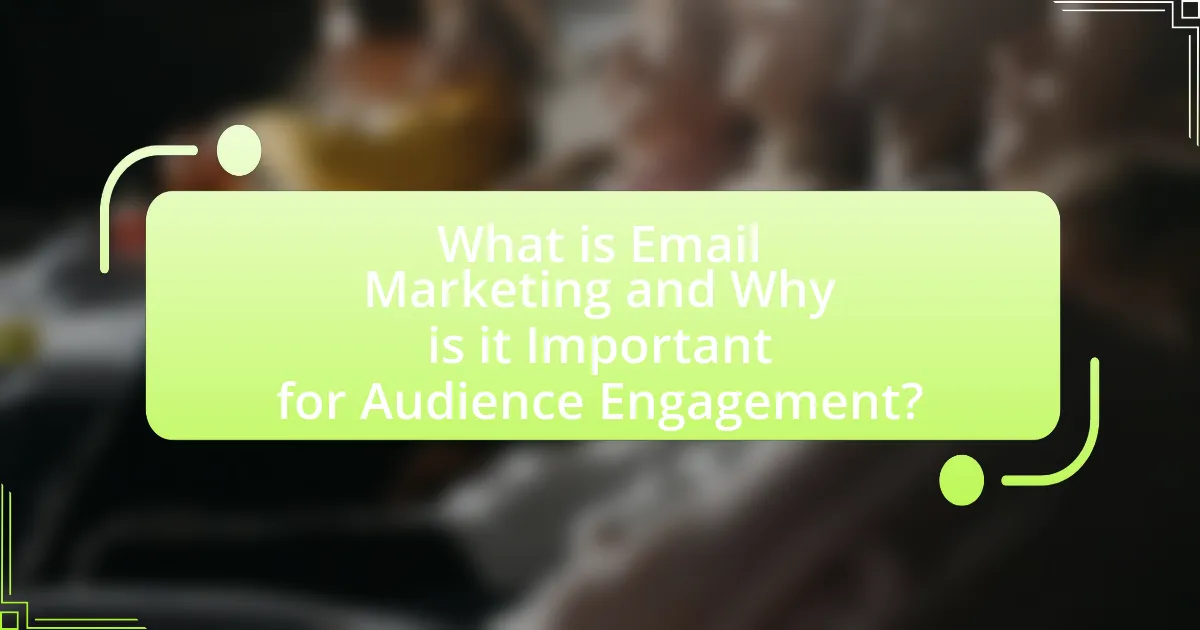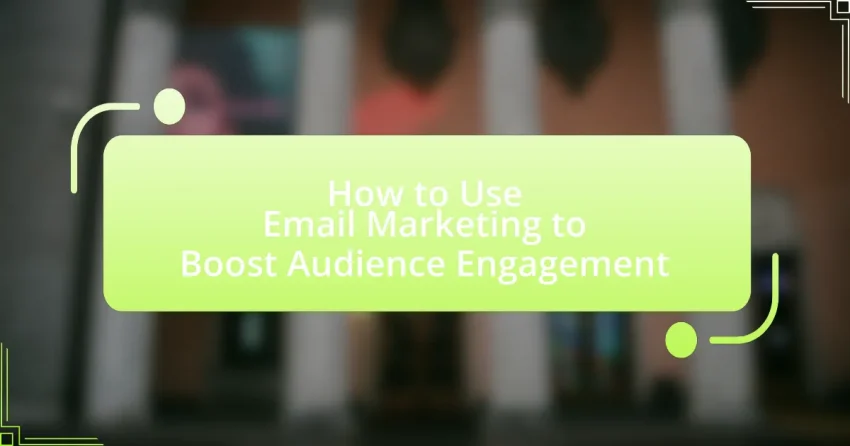Email marketing is a digital strategy that involves sending targeted emails to promote products, services, or content, playing a crucial role in audience engagement. This article outlines the importance of email marketing, highlighting its effectiveness in driving engagement with an average return on investment of $42 for every dollar spent. Key components of a successful email marketing strategy include audience segmentation, personalization, compelling content, and performance analytics. The article also discusses how to create effective campaigns, design engaging emails, and utilize A/B testing to enhance performance, while emphasizing the significance of tracking metrics such as open rates and conversion rates to measure success and inform future strategies.

What is Email Marketing and Why is it Important for Audience Engagement?
Email marketing is a digital marketing strategy that involves sending emails to a targeted audience to promote products, services, or content. It is important for audience engagement because it allows businesses to communicate directly with their customers, fostering relationships and encouraging interaction. According to a study by the Data & Marketing Association, email marketing has an average return on investment of $42 for every dollar spent, highlighting its effectiveness in driving engagement and conversions. Additionally, personalized email campaigns can increase click-through rates by 14% and conversion rates by 10%, demonstrating the significant impact of tailored messaging on audience engagement.
How does Email Marketing work to engage audiences?
Email marketing engages audiences by delivering targeted messages directly to their inboxes, fostering a personal connection. This method allows businesses to segment their audience based on behavior, preferences, and demographics, ensuring that the content is relevant and timely. According to a study by the Direct Marketing Association, email marketing has an average return on investment of $42 for every dollar spent, highlighting its effectiveness in driving engagement and conversions. By utilizing personalized content, automated campaigns, and interactive elements, email marketing not only captures attention but also encourages interaction, leading to higher engagement rates.
What are the key components of an effective email marketing strategy?
The key components of an effective email marketing strategy include a targeted audience, compelling content, personalization, segmentation, and performance analytics. Targeting the right audience ensures that emails reach individuals who are likely to engage with the content, which is crucial for high open and click-through rates. Compelling content captures attention and encourages action, while personalization enhances the relevance of the message, making recipients feel valued. Segmentation allows marketers to tailor messages based on specific characteristics or behaviors, increasing engagement rates. Finally, performance analytics provide insights into the effectiveness of campaigns, enabling continuous improvement. According to a study by the Direct Marketing Association, email marketing has an average return on investment of $42 for every dollar spent, underscoring the importance of these components in driving successful email campaigns.
How do audience segmentation and targeting enhance engagement?
Audience segmentation and targeting enhance engagement by allowing marketers to tailor their messages to specific groups based on shared characteristics or behaviors. This targeted approach increases the relevance of content, leading to higher open and click-through rates. For instance, a study by Mailchimp found that segmented email campaigns had a 14.31% higher open rate compared to non-segmented campaigns. By delivering personalized content that resonates with the audience’s interests and needs, businesses can foster stronger connections and drive more meaningful interactions.
What are the primary benefits of using Email Marketing for engagement?
The primary benefits of using Email Marketing for engagement include increased customer retention, personalized communication, and measurable results. Email marketing fosters customer loyalty by allowing businesses to send targeted messages that resonate with individual preferences, leading to higher engagement rates. According to a study by the Direct Marketing Association, email marketing has an average return on investment of $42 for every dollar spent, demonstrating its effectiveness in driving engagement. Additionally, email marketing platforms provide analytics that enable businesses to track open rates, click-through rates, and conversions, allowing for continuous improvement in engagement strategies.
How does Email Marketing improve customer retention?
Email marketing improves customer retention by fostering direct communication and personalized engagement with customers. This approach allows businesses to send targeted messages, offers, and updates that resonate with individual preferences, thereby enhancing customer loyalty. According to a study by the Direct Marketing Association, email marketing has an average return on investment of $42 for every dollar spent, indicating its effectiveness in maintaining customer relationships. Additionally, personalized emails can increase transaction rates by up to six times, demonstrating that tailored content significantly contributes to retaining customers.
What role does personalization play in audience engagement?
Personalization significantly enhances audience engagement by tailoring content to individual preferences and behaviors. When emails are personalized, such as by including the recipient’s name or recommending products based on past purchases, engagement rates can increase substantially. For instance, studies show that personalized emails can lead to a 29% higher open rate and a 41% higher click-through rate compared to non-personalized emails. This demonstrates that personalization not only captures attention but also fosters a deeper connection with the audience, ultimately driving higher engagement levels.

How to Create an Effective Email Marketing Campaign?
To create an effective email marketing campaign, start by defining clear objectives that align with your overall marketing goals. These objectives could include increasing brand awareness, generating leads, or boosting sales. Next, segment your audience based on demographics, behavior, or preferences to tailor your messaging effectively. Research shows that segmented campaigns can lead to a 760% increase in revenue, highlighting the importance of personalization.
Craft compelling subject lines that encourage opens, as 47% of email recipients decide whether to open an email based solely on the subject line. Ensure your email content is engaging, relevant, and provides value to the reader, incorporating strong calls to action that guide recipients toward the desired outcome.
Additionally, optimize your emails for mobile devices, as over 50% of emails are opened on mobile. Finally, analyze campaign performance through metrics such as open rates, click-through rates, and conversion rates to refine future campaigns. This data-driven approach ensures continuous improvement and effectiveness in your email marketing efforts.
What steps should be taken to design an engaging email?
To design an engaging email, start by crafting a compelling subject line that captures attention and encourages opens. Research indicates that 47% of email recipients decide whether to open an email based solely on the subject line. Next, personalize the email content by addressing the recipient by name and tailoring the message to their interests, which can increase engagement rates by up to 29%.
Incorporate visually appealing elements such as images and a clean layout to enhance readability; studies show that emails with images can increase click-through rates by 42%. Ensure the email is mobile-friendly, as over 50% of emails are opened on mobile devices. Finally, include a clear call-to-action that guides the reader on what to do next, as emails with a single call-to-action can increase clicks by 371%.
How do subject lines impact open rates and engagement?
Subject lines significantly impact open rates and engagement in email marketing. Research indicates that 33% of email recipients open emails based solely on the subject line. A compelling subject line can create curiosity, urgency, or relevance, prompting recipients to engage with the content. For instance, personalized subject lines can increase open rates by 26%, demonstrating the effectiveness of tailored messaging. Additionally, using action-oriented language and keeping subject lines concise—ideally under 50 characters—can further enhance engagement. These strategies underscore the critical role subject lines play in determining the success of email marketing campaigns.
What content types are most effective for audience engagement?
Visual content types, such as videos and infographics, are most effective for audience engagement. Research indicates that emails containing videos can increase click-through rates by up to 300%, while infographics are shared three times more than other types of content. Additionally, interactive content, like polls and quizzes, fosters higher engagement levels by encouraging audience participation. These content types not only capture attention but also enhance retention and sharing, making them crucial for effective email marketing strategies aimed at boosting audience engagement.
How can A/B testing improve email marketing effectiveness?
A/B testing can improve email marketing effectiveness by allowing marketers to compare two versions of an email to determine which one performs better in terms of open rates, click-through rates, and conversions. This method provides data-driven insights that help optimize email content, subject lines, and design elements. For instance, a study by Campaign Monitor found that segmented campaigns, which often utilize A/B testing, can lead to a 760% increase in revenue. By systematically testing different variables, marketers can make informed decisions that enhance engagement and drive better results.
What elements should be tested in an email campaign?
The elements that should be tested in an email campaign include subject lines, email content, call-to-action (CTA) buttons, images, send times, and audience segmentation. Testing subject lines can significantly impact open rates; for instance, a study by Campaign Monitor found that personalized subject lines can increase open rates by 26%. Email content should be evaluated for clarity and engagement, as A/B testing different formats can reveal what resonates best with the audience. The effectiveness of CTA buttons can be assessed by varying their placement, color, and wording, which can lead to higher click-through rates. Images should also be tested for their impact on engagement, as emails with visuals can increase engagement by up to 42%. Additionally, send times can affect open rates, with research indicating that emails sent on Tuesdays and Thursdays tend to perform better. Finally, audience segmentation allows for tailored messaging, which can improve conversion rates by 760%, according to HubSpot.
How do results from A/B testing inform future strategies?
Results from A/B testing inform future strategies by providing data-driven insights into audience preferences and behaviors. By comparing two versions of an email campaign, marketers can identify which elements—such as subject lines, content, or call-to-action buttons—resonate more effectively with recipients. For instance, a study by HubSpot found that personalized email subject lines can increase open rates by 26%. This evidence allows marketers to refine their strategies, focusing on the most effective tactics to enhance audience engagement in future campaigns.

What Metrics Should You Track to Measure Engagement Success?
To measure engagement success in email marketing, track open rates, click-through rates (CTR), conversion rates, and unsubscribe rates. Open rates indicate how many recipients opened the email, reflecting the effectiveness of subject lines and sender reputation. Click-through rates measure the percentage of recipients who clicked on links within the email, showcasing content relevance and call-to-action effectiveness. Conversion rates track the percentage of users who completed a desired action, such as making a purchase, highlighting the overall success of the campaign. Unsubscribe rates reveal how many recipients opted out, providing insight into content satisfaction and audience alignment. These metrics collectively offer a comprehensive view of engagement success in email marketing campaigns.
Which key performance indicators (KPIs) are essential for email marketing?
The essential key performance indicators (KPIs) for email marketing include open rate, click-through rate (CTR), conversion rate, bounce rate, and unsubscribe rate. Open rate measures the percentage of recipients who open an email, indicating the effectiveness of subject lines and sender recognition. Click-through rate assesses the percentage of recipients who click on links within the email, reflecting engagement levels. Conversion rate tracks the percentage of recipients who complete a desired action, such as making a purchase, demonstrating the email’s effectiveness in driving sales. Bounce rate indicates the percentage of emails that were not delivered, which can highlight issues with email list quality. Unsubscribe rate measures the percentage of recipients who opt out of future emails, providing insight into content relevance and audience satisfaction. These KPIs are critical for evaluating and optimizing email marketing campaigns to enhance audience engagement.
How do open rates and click-through rates reflect audience engagement?
Open rates and click-through rates are key metrics that directly reflect audience engagement in email marketing. Open rates indicate the percentage of recipients who open an email, demonstrating initial interest and relevance of the content to the audience. For instance, a high open rate, typically around 20-30% for many industries, suggests that the subject line and sender are compelling enough to capture attention.
Click-through rates, on the other hand, measure the percentage of recipients who click on links within the email, showcasing deeper engagement with the content. A click-through rate of 2-5% is considered average, and higher rates indicate that the email content resonates well with the audience, prompting them to take action. Together, these metrics provide insights into how effectively the email campaign engages the audience, guiding marketers in optimizing future communications based on recipient behavior and preferences.
What is the significance of conversion rates in email marketing?
Conversion rates in email marketing are crucial as they measure the effectiveness of email campaigns in driving desired actions from recipients, such as making a purchase or signing up for a service. High conversion rates indicate that the email content resonates with the audience, leading to increased engagement and revenue. For instance, according to a study by the Direct Marketing Association, email marketing has an average ROI of $42 for every dollar spent, highlighting the importance of optimizing conversion rates to maximize returns.
How can you analyze and interpret email marketing data?
To analyze and interpret email marketing data, marketers should focus on key performance indicators (KPIs) such as open rates, click-through rates (CTR), conversion rates, and unsubscribe rates. These metrics provide insights into how effectively emails engage the audience. For instance, a high open rate indicates that the subject line is compelling, while a low CTR may suggest that the email content or call-to-action needs improvement. According to a 2021 report by Mailchimp, the average open rate across industries is 21.33%, and the average CTR is 2.62%, which can serve as benchmarks for evaluating campaign performance. By comparing these metrics against industry standards and historical data, marketers can identify trends, optimize future campaigns, and enhance audience engagement.
What tools are available for tracking email marketing performance?
Tools available for tracking email marketing performance include Google Analytics, Mailchimp, HubSpot, and Constant Contact. Google Analytics allows users to track website traffic generated from email campaigns, providing insights into user behavior and conversion rates. Mailchimp offers built-in analytics that report on open rates, click-through rates, and subscriber engagement metrics. HubSpot provides comprehensive email tracking features, including A/B testing and detailed reporting on campaign performance. Constant Contact also offers analytics tools that help users measure the effectiveness of their email campaigns through metrics like bounce rates and engagement levels. These tools are widely recognized in the industry for their effectiveness in measuring and optimizing email marketing efforts.
How can data analysis inform future email marketing strategies?
Data analysis can inform future email marketing strategies by identifying customer preferences and behaviors, enabling marketers to tailor content effectively. For instance, analyzing open rates and click-through rates can reveal which subject lines and content types resonate most with the audience. According to a study by Mailchimp, segmented email campaigns have an average open rate of 14.32% compared to 11.45% for non-segmented campaigns, demonstrating the effectiveness of data-driven targeting. By leveraging insights from data analysis, marketers can optimize their email campaigns to enhance engagement and conversion rates.
What are some best practices for optimizing email marketing campaigns?
To optimize email marketing campaigns, focus on segmenting your audience, personalizing content, and analyzing performance metrics. Segmenting allows for targeted messaging, which can increase open rates by up to 14.31% according to Mailchimp. Personalization, such as using the recipient’s name and tailored recommendations, can lead to a 26% increase in open rates, as reported by Experian. Additionally, regularly analyzing metrics like open rates, click-through rates, and conversion rates enables marketers to refine their strategies based on data-driven insights, ensuring continuous improvement in campaign effectiveness.
How can you ensure compliance with email marketing regulations?
To ensure compliance with email marketing regulations, businesses must adhere to laws such as the CAN-SPAM Act in the United States and the General Data Protection Regulation (GDPR) in Europe. Compliance involves obtaining explicit consent from recipients before sending marketing emails, providing clear opt-out options in every email, and accurately identifying the sender. For instance, the CAN-SPAM Act mandates that commercial emails must include a valid physical postal address and a clear mechanism for recipients to unsubscribe. Additionally, GDPR requires that personal data is processed lawfully, transparently, and for specific purposes, emphasizing the importance of consent. Failure to comply can result in significant fines; for example, GDPR violations can lead to penalties of up to €20 million or 4% of annual global turnover, whichever is higher.
What strategies can enhance email deliverability and engagement?
To enhance email deliverability and engagement, implement strategies such as maintaining a clean email list, using double opt-in methods, and optimizing email content for mobile devices. A clean email list reduces bounce rates and improves sender reputation, as studies show that 20% of email addresses become invalid each year. Double opt-in methods ensure that subscribers genuinely want to receive emails, leading to higher engagement rates; research indicates that double opt-in can increase open rates by up to 50%. Additionally, optimizing content for mobile devices is crucial, as over 50% of emails are opened on mobile, and mobile-friendly designs can increase click-through rates by 15%.
